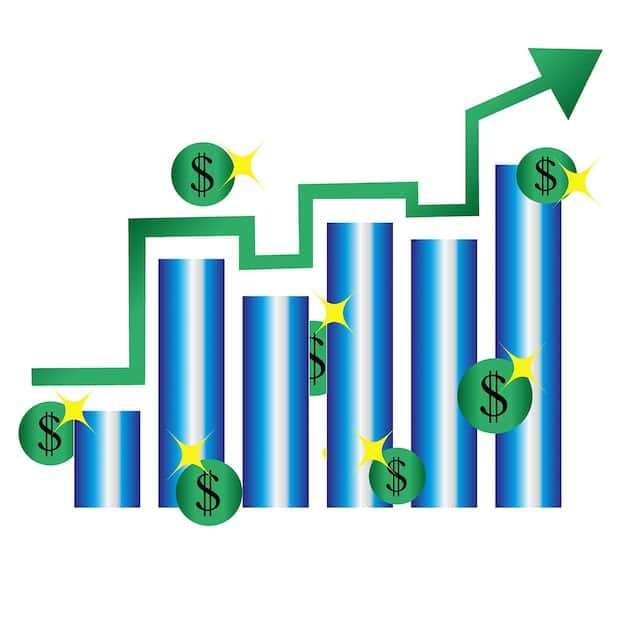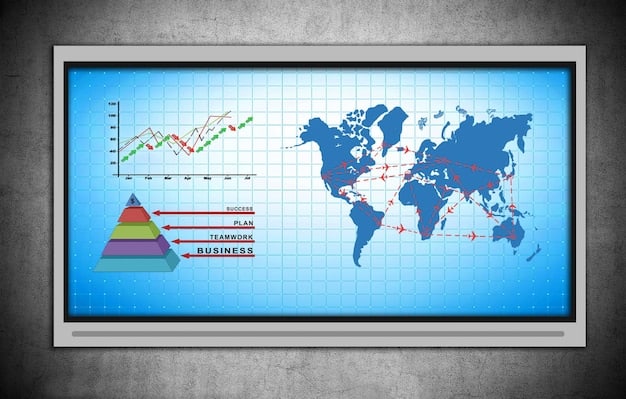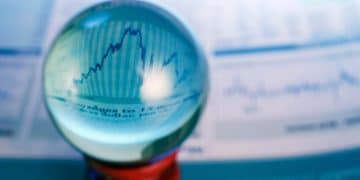New Corporate Tax Rate: Impact on US Business Investment 2025?

The potential impact of the new corporate tax rate on US business investments in 2025 remains a subject of intense debate among economists and policymakers, with various factors influencing forecasts.
As the calendar inches closer to 2025, one question weighs heavily on the minds of corporate executives, investors, and economists alike: Is the New Corporate Tax Rate Impacting US Business Investments in 2025? This isn’t merely a theoretical exercise; it delves into the tangible effects of fiscal policy on the nation’s economic pulse.
Understanding the Landscape of Corporate Taxation in 2025
The year 2025 stands as a critical juncture for US corporate taxation, largely due to anticipated shifts in policy that could reshape the economic playing field. Understanding the nuances of these changes is essential to gauge their potential influence on business investment decisions.
Historically, corporate tax rates have been a potent lever for governments to stimulate or temper economic activity. Lower rates are often pitched as incentives for companies to reinvest profits, expand operations, and create jobs. Conversely, higher rates can generate more government revenue, potentially for public services, but critics argue they might disincentivize domestic investment.
Historical Context of US Corporate Tax Reforms
To fully appreciate the 2025 outlook, a brief look back is often illuminating. The Tax Cuts and Jobs Act (TCJA) of 2017 represented a significant overhaul, dramatically lowering the federal corporate income tax rate from 35% to 21%. Proponents claimed this reduction would unleash a wave of investment and economic growth. Detractors argued it disproportionately benefited large corporations and wealthy shareholders, with limited trickle-down effects.
- Pre-TCJA (Prior to 2018): US corporate tax rate was among the highest in developed nations, often cited at 35%.
- TCJA (2018 onwards): A substantial reduction to a flat 21% rate, aimed at making the US more competitive.
- Proposed Changes for 2025: Discussions revolve around potential increases to the corporate tax rate, or adjustments to deductions and credits, that could effectively raise the tax burden.
These past reforms provide a template for evaluating the upcoming changes. The economic response to TCJA generated mixed reviews, with some studies pointing to increased share buybacks and dividends rather than a significant surge in capital expenditures. This historical precedent shapes current debates about whether new tax policies will truly foster productive investment or simply alter corporate financial strategies.
The 2025 landscape is complex, with ongoing legislative debates, economic forecasts, and global competitive pressures all playing a role. Businesses are closely watching these developments, seeking clarity to inform their long-term strategic plans and investment pathways.
Key Proposals and Their Immediate Implications for Businesses
The discourse surrounding corporate tax rates for 2025 isn’t just theoretical; it involves concrete proposals that, if enacted, could have immediate and tangible effects on businesses across the United States. These proposals vary in scope and ambition, but all share the common goal of altering the fiscal environment for corporations.
One prominent set of proposals focuses on raising the corporate tax rate from the current 21%. Advocates for such increases often argue that it would ensure corporations pay a fairer share, generate revenue for public programs, and potentially curb excessive corporate profits. The suggested new rates often fall within the 25% to 28% range, though some proposals have pushed for even higher figures. A change of even a few percentage points can translate into billions of dollars for large corporations, directly impacting their bottom line.
Potential Changes to Tax Credits and Deductions
Beyond the headline tax rate, proposals often include adjustments to corporate tax credits and deductions. These can be just as impactful as a direct rate change, subtly shifting the true tax burden. For instance, proposals might target specific deductions that are perceived as loopholes, or introduce new credits to incentivize certain behaviors, like investment in green technologies or domestic manufacturing.
- R&D Tax Credit Adjustments: Discussions often include whether to fully refund or expand the research and development (R&D) tax credit, influencing innovation spending.
- Depreciation Schedules: Changes to how quickly companies can deduct the cost of assets (depreciation) can significantly affect the timing and attractiveness of capital investments.
- International Tax Rules: Reforms to global intangible low-taxed income (GILTI) or base erosion and anti-abuse tax (BEAT) provisions could alter how multinational corporations structure their operations and repatriate profits.
The immediate implications for businesses are multifaceted. A higher statutory rate, coupled with reduced deductions, could lead to a decrease in after-tax profits, potentially limiting funds available for reinvestment, expansion, or shareholder distributions. Businesses might respond by re-evaluating capital expenditure projects, delaying hiring, or seeking greater efficiencies in their operations to offset the increased tax burden.

Furthermore, the uncertainty surrounding these proposals can itself be a deterrent to investment. Businesses thrive on predictability, and a fluctuating or unclear tax environment makes long-term planning challenging. Companies might adopt a wait-and-see approach, deferring significant investment decisions until there is greater clarity on the final tax landscape for 2025 and beyond.
Economic Theories on Corporate Tax and Investment
The relationship between corporate taxation and business investment is a cornerstone of economic debate, underpinned by various theories that attempt to explain how changes in tax policy influence corporate behavior. Understanding these perspectives is crucial for analyzing the potential real-world effects of a new corporate tax rate in 2025.
One dominant theory is the **Neoclassical Investment Theory**. This framework suggests that firms invest in capital goods up to the point where the marginal benefit of an additional unit of capital equals its marginal cost. Corporate taxes, in this view, increase the cost of capital by reducing the after-tax return on investment. Therefore, a higher corporate tax rate is expected to decrease business investment because it makes less projects profitable. Conversely, lower rates reduce the cost of capital, making more projects financially viable and stimulating investment.
Supply-Side Economics vs. Demand-Side Economics
The debate often boils down to a dichotomy between supply-side and demand-side economic perspectives. **Supply-side economics** largely aligns with the neoclassical view, emphasizing that lower corporate taxes encourage businesses to produce more, invest more, and ultimately boost overall economic supply. Proponents argue that the benefits “trickle down” through increased wages, employment, and innovation. They would predict that a higher tax rate in 2025 would inevitably lead to a reduction in business investment.
On the other hand, **demand-side economics** (often associated with Keynesian principles) contends that while tax rates can play a role, aggregate demand is a more significant driver of investment. In this view, if there’s insufficient consumer spending or government investment, businesses won’t invest even if tax rates are low, because there’s no market for their increased output. They might argue that a higher corporate tax rate, if accompanied by increased government spending on infrastructure or social programs, could indirectly stimulate investment by boosting overall demand.
- Tax Incidence: A key aspect of these theories is tax incidence — who ultimately bears the burden of the tax. Is it shareholders, consumers (through higher prices), or workers (through lower wages)? The answer dictates how the tax impacts investment incentives.
- Tax Elasticity of Investment: Economists attempt to quantify how sensitive business investment is to changes in the corporate tax rate. Studies vary, but generally suggest some degree of elasticity, meaning investment does respond to tax changes, though the magnitude is debated.
Furthermore, behavioral economics introduces the idea that corporate decisions are not always perfectly rational. Factors such as corporate culture, managerial incentives, and short-term market pressures can influence investment decisions alongside pure tax considerations. This perspective suggests that while tax rates are important, they are part of a larger ecosystem of factors guiding business behavior.
Ultimately, the predictive power of these theories for 2025 depends on the specific design of the tax reform, the prevailing economic conditions, and how businesses collectively interpret and respond to the new fiscal reality.
Empirical Evidence and Recent Trends in US Investment
While economic theories provide conceptual frameworks, empirical evidence offers real-world data to evaluate the actual relationship between corporate tax rates and business investment. Analyzing recent trends in US business investment against the backdrop of past tax reforms can provide valuable insights for 2025.
Following the significant reduction in the corporate tax rate under the TCJA in 2017, many expected a robust acceleration in business investment. The immediate aftermath did see some increase in capital expenditures, particularly in the first year or two. However, the sustained, dramatic surge predicted by some supply-side advocates largely did not materialize universally across all sectors, or for an extended period.
Factors Beyond Tax Rates Influencing Investment
Several studies and analyses pointed to other overriding factors that often play a more dominant role in investment decisions than tax rates alone:
- Economic Growth Outlook: Businesses are more likely to invest when they anticipate strong demand for their products and services. A robust economy with healthy consumer spending and global trade tends to stimulate investment, regardless of minor tax fluctuations.
- Interest Rates and Cost of Capital: The prevailing interest rates set by the Federal Reserve, along with access to affordable credit, significantly impact the cost of borrowing for investment projects. Lower interest rates can make even marginally profitable ventures attractive.
- Technological Innovation: Rapid advancements in technology often necessitate new investments in equipment, software, and R&D for businesses to remain competitive, pushing investment regardless of tax changes.
- Regulatory Environment: The ease or difficulty of doing business, influenced by regulations pertaining to environmental standards, labor laws, and industry-specific rules, can also affect investment appetite.
- Global Competition: US companies operate within a globalized economy. Investment decisions are also influenced by the tax and regulatory environments in other countries, as firms consider where to deploy capital most efficiently.
Recent data indicates that while investment picked up, the corporate tax cuts were also accompanied by a significant increase in share buybacks and dividend payments to shareholders. This suggests that a portion of the tax savings was directed towards financial engineering rather than solely towards capital expenditure and job creation. This observation fuels the argument that simply lowering tax rates might not guarantee a proportionate increase in productive investment.

For 2025, if the corporate tax rate does increase, the empirical evidence hints that the impact on investment might not be as severe as some predict, especially if other factors remain favorable. Conversely, a reduction might not automatically trigger a massive investment boom. The confluence of these various economic forces will ultimately determine the aggregate effect on US business investments.
Sector-Specific Analysis and Differentiated Impacts
The potential impact of a new corporate tax rate in 2025 will not be uniform across all sectors of the US economy. Different industries possess unique characteristics, capital expenditure requirements, and revenue structures that make them more or less sensitive to changes in corporate taxation. A sector-specific analysis reveals a more nuanced picture of how businesses might respond.
Highly Capital-Intensive Industries
Industries that require substantial upfront investments in machinery, infrastructure, or intellectual property are often considered most sensitive to corporate tax changes. Examples include manufacturing, energy, telecommunications, and certain segments of technology that rely heavily on large-scale R&D. For these sectors, a higher corporate tax rate could directly increase the cost of capital and dampen enthusiasm for major new projects.
- Manufacturing: Often invests heavily in plant and equipment. Higher taxes could reduce the attractiveness of upgrading facilities or expanding production lines domestically.
- Energy (Oil & Gas, Renewables): Requires massive capital outlays for exploration, extraction, or renewable energy infrastructure. The long lead times and high costs mean tax policy plays a significant role in project viability.
- Telecommunications: Continuous investment in network upgrades (e.g., 5G, fiber optics) is critical. Reduced after-tax profits could slow down these essential infrastructure developments.
Conversely, a lower tax rate disproportionately benefits these sectors by improving the profitability of their inherently high-cost ventures. This often leads to lobbying efforts from these industries who argue for stable or lower tax burdens to foster growth and innovation.
Service-Oriented and Labor-Intensive Industries
On the other hand, service-oriented industries, like consulting, healthcare, retail, and many professional services, might be less directly impacted by changes in corporate tax rates on their investment decisions. While they certainly pay corporate taxes, their primary “investment” is often in human capital (staffing, training) rather than physical assets.
For these sectors, the immediate effects of a tax change might be more visible in profit margins or shareholder returns, rather than a dramatic shift in capital expenditure. Their growth is often tied more closely to consumer demand, labor availability, and skill development.
Furthermore, smaller businesses and startups, regardless of their sector, might experience varying degrees of impact. Many small businesses are structured as pass-through entities (e.g., S-corps, LLCs) and thus pay taxes at the individual, not corporate, rate. However, larger small businesses that are structured as C-corporations would certainly feel the direct effects of any rate change.
The differentiated impacts mean that a new corporate tax rate in 2025 could lead to winners and losers among industries, potentially shifting the competitive landscape and influencing investment flows between sectors. Policymakers often face the challenge of designing tax laws that promote overall economic health without unduly disadvantaging specific, strategically important industries.
Policy Alternatives and Mitigating Measures
Recognizing the potential repercussions of corporate tax policy on business investment, policymakers often consider various alternatives and mitigating measures to balance revenue generation with economic growth incentives. The debate around the 2025 corporate tax rate isn’t just about setting a number; it’s about crafting an entire fiscal framework that supports broader economic objectives.
Targeted Tax Incentives
Instead of, or in addition to, broad corporate tax rate changes, governments can employ targeted tax incentives to direct investment into specific areas. These could include:
- Investment Tax Credits (ITCs): Providing tax credits for specific types of capital expenditures, such as investment in renewable energy, advanced manufacturing equipment, or R&D. ITCs directly reduce the cost of these investments, making them more attractive.
- Accelerated Depreciation: Allowing businesses to deduct the cost of capital assets more quickly for tax purposes. This effectively defers tax payments, providing a cash flow benefit that can encourage immediate investment.
- Location-Based Incentives: Offering tax breaks for businesses that invest in economically distressed areas or specific regions the government aims to revitalize.
These targeted measures allow policymakers to precision-engineer incentives, addressing market failures or promoting strategic industries without altering the entire corporate tax structure. However, they also add complexity to the tax code and can sometimes lead to companies shifting existing activities to qualify for new breaks rather than creating genuinely new investment.
Non-Tax Policy Levers
Beyond tax policy, governments possess other powerful levers to influence business investment. These non-tax measures can often complement fiscal policy to create a more holistic environment for growth:
- Infrastructure Spending: Investing in roads, bridges, broadband, and energy grids can significantly reduce the cost of doing business, making new projects more viable. Improved infrastructure can open up new markets and enhance supply chain efficiency.
- Workforce Development: Funding education and training programs ensures a skilled labor force, a critical factor for businesses considering expansion or new endeavors. A robust talent pipeline mitigates hiring risks and lowers training costs for companies.
- Regulatory Streamlining: Reducing unnecessary bureaucratic hurdles and complex regulations can lower compliance costs and speed up project approvals, making the US a more attractive place to invest.
- Trade Policies: Favorable trade agreements and stability in international relations can open up export markets, encouraging businesses to expand production capacities.
The discussion around the new corporate tax rate for 2025 is thus part of a much larger conversation about economic stewardship. Policymakers must weigh the revenue needs against the imperative to foster a competitive and dynamic business environment. A balanced approach that integrates both tax and non-tax strategies is often seen as the most effective path to sustainable investment growth.
Forecasting the Future: Scenarios for 2025 and Beyond
Predicting the precise impact of a new corporate tax rate on US business investments in 2025 involves navigating a complex web of economic variables, policy choices, and unforeseen global events. While definitive forecasts are challenging, outlining plausible scenarios based on current discussions can help stakeholders prepare.
One scenario posits a **moderate increase in the corporate tax rate**, perhaps to 25% or 28%, accompanied by minor adjustments to deductions or credits. In this case, the immediate impact on overall investment might be perceptible but not catastrophic. Capital-intensive industries would likely feel a pinch, but diversified businesses and service sectors might adapt with less disruption. Investors might reallocate capital slightly, perhaps favoring sectors perceived as less tax-sensitive. The overall macroeconomic effect would largely depend on the broader economic climate, including inflation, interest rates, and global demand.
A second, more aggressive scenario envisions a **larger corporate tax hike**, potentially approaching pre-TCJA levels, coupled with significant changes to tax breaks. Under this scenario, a more pronounced slowdown in certain types of domestic investments could occur. Multinational corporations might re-evaluate where they choose to locate new facilities or R&D centers, potentially shifting some capital expenditure overseas. This could lead to concerns about US competitiveness and job creation, particularly in manufacturing and technology sectors requiring substantial capital outlays. This scenario would likely trigger more significant financial market reactions as well.
Conversely, a third scenario involves **minimal or no changes to the existing corporate tax rate**, or perhaps even very targeted incentives offset by other revenue measures. In this case, the tax environment for businesses would remain relatively stable. Investment decisions would then be predominantly driven by factors like technological advancements, market opportunities, consumer demand, and global economic stability. This scenario suggests a continuation of current investment trends, barring other major economic shifts.
Forecasting the future also requires considering exogenous factors that lie outside tax policy:
- Global Economic Health: A robust global economy with strong trade can offset domestic tax disadvantages, while a downturn amplifies them.
- Technological Disruption: Breakthrough innovations can spur massive investment, regardless of tax rates, as companies strive for competitive advantage.
- Consumer Spending Patterns: Strong consumer demand fuels business confidence and investment.
- Geopolitical Stability: Periods of geopolitical uncertainty can lead businesses to defer investment, prioritizing capital preservation.
Ultimately, the actual impact in 2025 will likely be a blend of these scenarios, influenced by the specific final legislation, the adaptive strategies of businesses, and the ever-evolving global economic landscape. Businesses should prepare for a range of contingencies, focusing on financial resilience and strategic agility.
| Key Point | Brief Description |
|---|---|
| 📈 Policy Proposals | Discussions for 2025 include rate hikes (25-28%) and adjustments to credits/deductions. |
| 💡 Economic Theories | Neoclassical theory suggests higher taxes reduce investment by increasing capital cost. |
| 📊 Empirical Trends | Past tax cuts led to some investment, but also share buybacks; other factors like growth rate are crucial. |
| 🏛️ Policy Alternatives | Targeted tax credits, accelerated depreciation, infrastructure spending, and workforce development. |
Frequently Asked Questions About Corporate Tax and Investment
▼
The current US federal corporate tax rate is 21%, as established by the Tax Cuts and Jobs Act (TCJA) of 2017. This rate has been in effect since January 1, 2018, representing a significant reduction from the previous statutory rate of 35%.
▼
Corporate tax rates directly impact a company’s after-tax profits. Lower rates can increase the profitability of investment projects, potentially encouraging more capital expenditure, R&D, and expansion. Conversely, higher rates can reduce the attractiveness of such investments, leading companies to prioritize other uses for capital.
▼
No, the impact will likely vary significantly by industry. Capital-intensive sectors like manufacturing, energy, and telecommunications, which make large investments in physical assets, tend to be more sensitive. Service-oriented and labor-intensive industries may experience less direct impact on their capital investment decisions, though overall profitability will still be affected.
▼
Tax incidence refers to who ultimately bears the economic burden of a tax, regardless of who initially pays it. In corporate taxation, the burden could fall on shareholders (through lower returns), consumers (through higher prices), or employees (through lower wages), or a combination of these groups, influencing the tax’s broader economic effects.
▼
Yes, non-tax policies such as investments in infrastructure, robust workforce development programs, regulatory streamlining, and stable international trade agreements can all significantly encourage business investment. These measures improve the overall business environment, making it more attractive for companies to grow and expand domestically.
Conclusion
The question of whether a new corporate tax rate will impact US business investments in 2025 is multifaceted, extending beyond a simple “yes” or “no.” While economic theories generally suggest that higher taxes can dampen investment by increasing the cost of capital, empirical evidence indicates that businesses consider a broader array of factors, including overall economic growth, interest rates, and technological imperatives. The ultimate effect will hinge on the specifics of any enacted tax legislation, the prevailing economic conditions, and the strategic adaptations of businesses across diverse sectors. Understanding this intricate interplay is crucial as 2025 approaches, guiding both policy decisions and corporate strategies toward sustained economic vitality.





